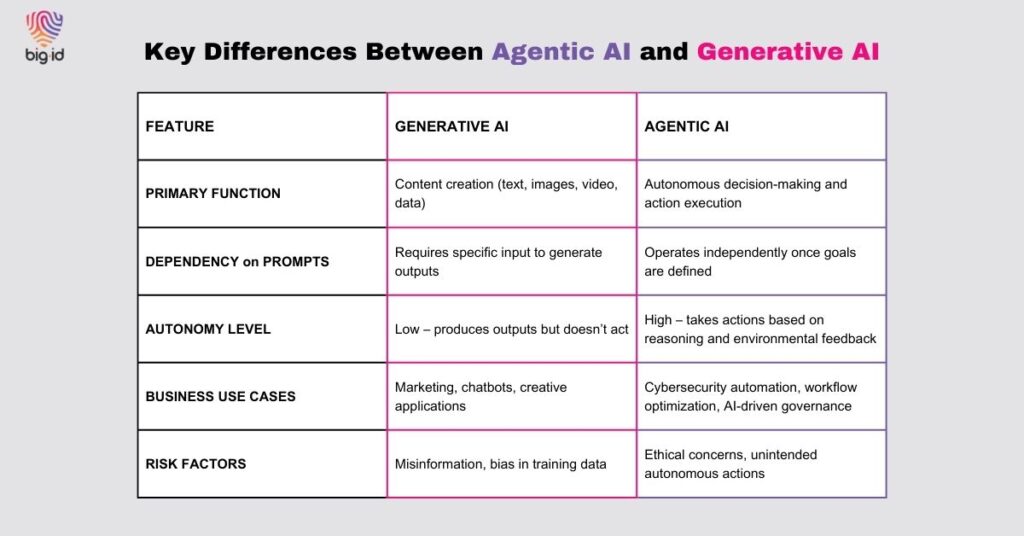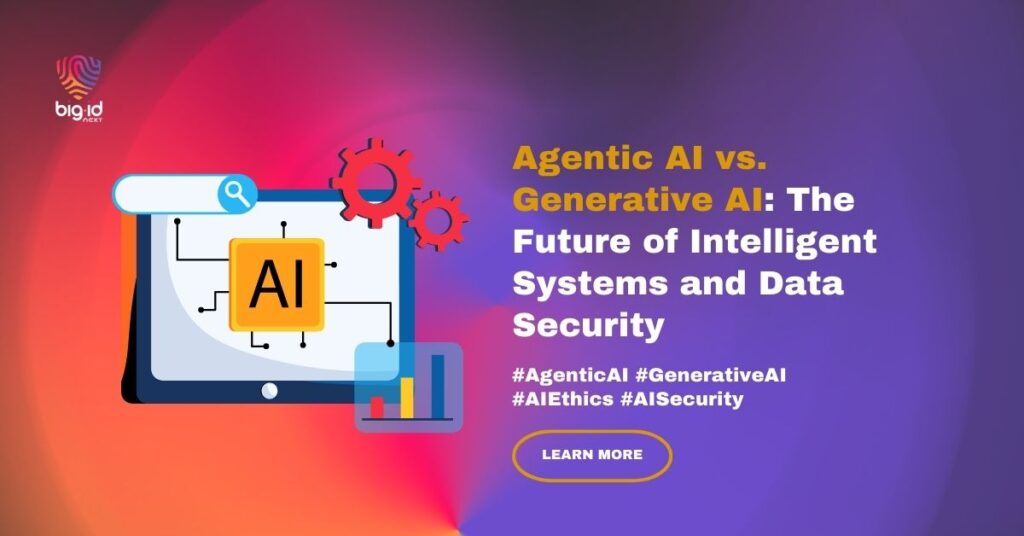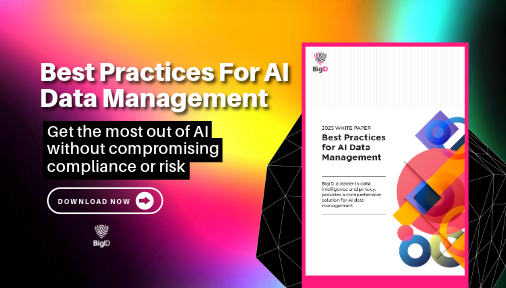Agentic AI vs Generative AI
The rapid adoption of artificial intelligence has transformed how businesses handle data, security, and decision-making. However, not all AI systems are built the same. Two emerging AI paradigms—Agentic AI and Generative AI—are redefining automation, intelligence, and interaction. Organizations managing sensitive data must grasp their core differences to leverage AI technology responsibly for privacy, security, governance, and business agility.
What Is Generative AI?
Generative artificial intelligence refers to a type of AI model that creates content, whether text, images, video, or code. These models, like OpenAI’s ChatGPT, GPT-4 and DALL·E, analyze vast amounts of data to generate human-like responses, artistic visuals, or synthetic datasets based on patterns.
Generative AI excels in:
- Content creation: Automating blog posts, reports, or marketing materials.
- Code generation: Assisting developers by writing or optimizing code.
- Data augmentation: Producing synthetic data to train machine learning models.
- Personalization: Enhancing user experiences through tailored recommendations.
What Is Agentic AI?
Agentic AI refers to systems that take AI use a step further by adding autonomy, decision-making, and goal-directed behavior. Unlike Generative AI, which primarily outputs content based on user input, Agentic AI can operate independently to:
- Analyze, reason, and make decisions without constant human intervention.
- Execute tasks across multiple steps, adjusting strategies based on environmental feedback.
- Automate workflows, improving operational efficiency.
- Enhance cybersecurity through autonomous threat detection and mitigation.
This type of AI is often deployed where automation must go beyond generation, requiring systems to achieve specific goals and operate independently. Agentic AI focuses on decision-making and task execution.
Agentic AI also appears in use cases like autonomous agents for cybersecurity, self-learning business automation tools, and AI agents that can independently complete tasks without user guidance at every step.

Agentic AI and Generative AI: Key Differences, Benefits, and Challenges
As AI is emerging in new forms, understanding the AI landscape, particularly the core differences between agentic AI tools and generative AI tools, is key to selecting the right solutions for your business needs.
Benefits of Generative AI
- Accelerates Content Production: Reduces time and resources spent on content creation.
- Enhances Creativity: Assists professionals in generating new ideas and designs.
- Improves Data Analysis: Synthesizes complex data into digestible reports.
- Scales Personalization: Powers dynamic user experiences, such as chatbots and recommendation engines.
Challenges of Generative AI
- Data Privacy Risks: Sensitive information can unintentionally appear in generated content.
- Misinformation and Bias: AI may create false or biased narratives based on flawed training data.
- Intellectual Property Concerns: AI-generated content raises copyright and ownership issues.
Benefits of Agentic AI
- Automates Decision-Making: Reduces reliance on human oversight for routine decisions.
- Improves Cybersecurity: Detects and neutralizes threats without human intervention.
- Optimizes Business Operations: Enhances efficiency by managing workflows.
- Enhances Governance & Compliance: Ensures adherence to data policies and regulatory frameworks.
Challenges of Agentic AI
- Control and Predictability: Autonomous decision-making can be difficult to monitor.
- Ethical Concerns: Decisions made without human oversight may pose risks.
- Security Risks: If compromised, autonomous AI can cause unintended disruptions.
Agentic AI becomes essential when businesses need systems that act with minimal oversight. However, understanding the autonomy of agentic AI is critical to managing associated risks.

Why Organizations Managing Sensitive Data Should Care About AI Use Case
Data Privacy and Security Implications
Both Generative AI and agentic AI systems don’t operate without risks—especially concerning sensitive data. They both impact how businesses handle this information.
- Generative AI poses risks related to data leakage and unauthorized content creation.
- Agentic AI, if misconfigured, could make unauthorized changes to systems or expose sensitive information through flawed automation.
Organizations must enforce stringent security policies, including:
- AI-driven data classification to ensure models handle information appropriately.
- Robust monitoring systems to prevent AI-generated data breaches.
- Ethical AI governance to mitigate risks associated with autonomous decision-making.
Governance and Compliance Considerations
Regulatory frameworks like GDPR, CCPA, and emerging AI governance laws require businesses to control how AI interacts with sensitive data.
- Generative AI must comply with data handling regulations to prevent exposure of personal information.
- Agentic AI must align with governance frameworks to ensure accountability in autonomous decision-making.
Business Agility and AI Adoption
To stay competitive, enterprises must strategically use AI solutions while maintaining trust and control.
- Generative AI can enhance creativity and innovation, fueling business agility.
- Agentic AI can adapt to changing environments and improve operational resilience, reducing human workload and response times in critical scenarios like cybersecurity threats.
The Future of AI: A Combined Approach
While Generative AI and Agentic AI serve distinct functions, the future will likely involve hybrid models that blend generative creativity with agentic capabilities.
AI-Driven Security Teams
Security teams can leverage Generative AI to simulate potential cyber threats by generating realistic phishing emails, malware, and penetration test scenarios. Meanwhile, Agentic AI can autonomously detect, analyze, and mitigate these threats in real time, adjusting security protocols dynamically. For example, a Generative AI system could create evolving attack patterns, while an Agentic AI defense system continuously adapts, learns, and neutralizes threats as they emerge.
Regulatory Compliance AI
Businesses must comply with evolving regulations around data security, privacy, and governance. Generative AI can analyze complex legal texts, extract key compliance requirements, and summarize them in an actionable format. Agentic AI can then enforce compliance by automatically updating security policies, monitoring adherence, and flagging potential violations. For instance, a financial institution could use Generative AI to process regulatory changes and an Agentic AI system to implement necessary controls across its databases in real time.
Business Intelligence and Investment Decisions
Generative AI can summarize vast amounts of market data, identifying trends, consumer behavior shifts, and competitive insights. Agentic AI, on the other hand, can take action by making automated, data-driven investment decisions or supply chain optimizations. For example, a hedge fund could employ Generative AI to generate market forecasts and an Agentic AI system to execute trades based on predefined risk parameters, maximizing efficiency and minimizing human error.
Organizations that strategically combine these AI capabilities will be better positioned to innovate while maintaining control over security, privacy, and governance.
Securing AI Ecosystems with BigID Next
Agentic AI and Generative AI are reshaping how enterprises handle automation, intelligence, and security. Businesses managing sensitive data must navigate these technologies carefully, balancing innovation with risk mitigation. Whether enhancing content creation or streamlining governance, AI’s role will only expand—making it crucial for organizations to adopt responsible AI practices that ensure security, compliance, and business agility.
BigID Next is the first modular data platform to address the entirety of data risk across security, regulatory compliance, and AI. It eliminates the need for disparate, siloed solutions by combining the capabilities of DSPM, DLP, data access governance, AI model governance, privacy, data retention, and more — all within a single, cloud-native platform.
Here’s how BigID Next helps organizations transform AI risk:
- Complete Auto-Discovery of AI Data Assets: BigID Next’s auto-discovery goes beyond traditional data scanning by detecting both managed and unmanaged AI assets across cloud and on-prem environments. BigID Next automatically identifies, inventories, and maps all AI-related data assets — including models, datasets, and vectors.
- First DSPM to Scan AI Vector Databases: During the Retrieval-Augmented Generation (RAG) process, vectors retain traces of the original data they reference, which can inadvertently include sensitive information. BigID Next identifies and mitigates the exposure of Personally Identifiable Information (PII) and other high-risk data embedded in vectors, ensuring your AI pipeline remains secure and compliant.
- AI Assistants for Security, Privacy, and Compliance: BigID Next introduces the first-of-its-kind agentic AI assistants, designed to help enterprises prioritize security risks, automate privacy programs, and support data stewards with intelligent recommendations. These AI-driven copilots ensure compliance stays proactive, not reactive.
- Risk Posture Alerting and Management: AI systems introduce data risks that go beyond the data itself — and extend to those with access to sensitive data and models. BigID Next’s enhanced risk posture alerting continuously tracks and manages access risks, providing visibility into who can access what data. This is especially critical in AI environments, where large groups of users often interact with sensitive models and datasets. With BigID Next, you can proactively assess data exposure, enforce access controls, and strengthen security to protect your AI data.
To see how BigID Next can help you secure your entire AI ecosystem — get a 1:1 demo with our experts today.



